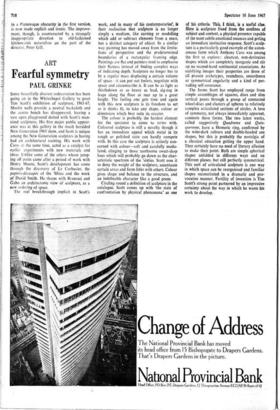Fearful symmetry
ART PAUL GRINKE
Some beautifully discreet redecoration has been going on in the Whitechapel Gallery to greet Tim Scott's exhibition of sculpture, 1961-67. Muslin walls provide a neutral backcloth and the centre bench has disappeared, leaving a vast open playground dotted with Scott's man- sized sculptures. His first major public appear- ance was at this gallery in the much heralded New Generation 1965 show, and Scott is unique among the New Generation sculptors in having had an architectural training. His work with Caro. at the same time, acted as a catalyst for earlier experiments with new materials and ideas. Unlike some of the others whose jump- ing off point came after a period of work with Henry Moore, Scott's development has come through the discovery of Le Corbusier, the papiers-dkoupes of the 'fifties and the work of David Smith. He shares with Brancusi and Cabo an architectonic view of sculpture, as a new ordering of space.
The real breakthrough implicit in Scott's work, and in many of his contemporaries', is their realisation that sculpture is no longer simply a medium, like carving or modelling which add or subtract elements from a mass, but a distinct category of object. In a similar way painting has moved away from the limita- tions of perspective and the predetermined boundaries of a rectangular framing edge. Paintings are flat and painters tend to emphasise their flatness instead of finding complex ways of indicating depth. Sculpture no longer has to be a regular mass displacing a certain volume of space - it can put out feelers, negotiate with space and circumscribe it. It can be as light as thistledown or as heavy as lead, zig-zag in leaps along the floor or rear up to a great height. The feeling one gets time and again with this new sculpture is its freedom to act as it thinks fit, to take any shape, colour or dimension which best suits its creator.
The colour is probably the hardest element for the spectator to come to terms with. Coloured sculpture is still a novelty though it has an immediate appeal which metal in its rough or polished state can hardly compete with. In this case the sculpture is actively con- cerned with colour—soft and carefully modu- lated, clinging to those toothsome sweet-shop hues which will probably go down as the char- acteristic spectrum of the 'sixties. Scott uses it to deny the weight of the sculpture, accentuate certain areas and form links with others. Colour gives shape and balance to the structure, and an indefinable character like a good poem.
Circling round a definition of sculpture in the catalogue, Scott comes up with 'the state of confrontation by physical phenomena' as one of his criteria. This, I think, is a useful clue. here is sculpture freed from the confines of subject and content, a physical presence capable of the most subtle emotional nuances and getting an immediate instinctive response. Scott's sculp- ture is a particularly good example of the auton- omous form which Anthony Caro was among the first to explore: cleancut, non-derivative shapes which are completely inorganic and stir up no second-hand sentimental associations. As satisfying images their properties are those of all proven archetypes, roundness, smoothness or symmetrical angularity and a kind of per- vading self-assurance.
The forms Scott has employed range from simple assemblages of squares, discs and slim vertical panes through a group of connected wheel-discs and clusters of spheres to relatively complex articulated sections of circles. A love of symmetry, not always immediately apparent, connects these forms. The two latest works, called suggestively Quad reme and Quin- quereme, have a Homeric ring, confirmed by the wine-dark colours and double-headed axe shapes, but this is probably the nostalgia of a classical education getting the upper hand. They certainly have no need of literary allusion to make their point. Both are simple spherical shapes unfolded in different ways and on different planes, but still perfectly symmetrical. This sort of articulated sculpture is one way in which space can be reorganised and familiar shapes reconstituted in a dramatic and pro- vocative manner. Fertility of invention is Tim Scott's strong point partnered by an impressive certainty about the way in which he wants his work to develop.


































 Previous page
Previous page